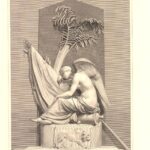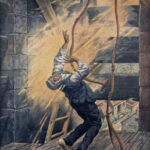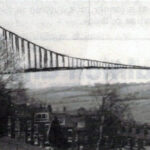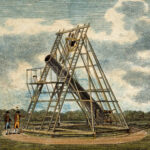29 June 1876: Uplifted, Harrogate parish church awaits the monstrous £1,800 Schulze organ from Thomas Stuart Kennedy’s Meanwood Towers, Leeds
Leeds Mercury. 1876/06/29. Edmund Schulze and His Organs. Leeds. Get it:
.Excerpt
One of the most important instruments in this country will shortly be transferred from a private room in Leeds to a more suitable and fortunately public building. The church of St. Peter’s, Harrogate, has had its transepts raised to a height of fifty-five feet for its reception. The instrument we refer to is the magnificent one built by the greatest of all organ builders, Edmund Schulze, for Mr T.S. Kennedy, of Meanwood. Mr Kennedy has been induced to part with this valuable property, through the maker having stated that the organ would inevitably be destroyed if it were allowed to remain in its present location, the building, though specially built for it, being of wood, and consequently not weather-tight. For so valuable an acquisition, the church in Harrogate is indebted to the liberality of the Misses Carter, of Fern Villa, Harrogate. There are, we believe, only seven organs in this country by the same celebrated builder. Schulze was first brought into notice in England by the noble instrument which he sent to the International Exhibition of 1851, which was afterwards removed to a public room at Northampton. The next he supplied was the famous one in Doncaster parish church. Of the others, one is at South Shields, another is the private property of Mr Thomas Walker, of Seaton Carew, near Hartlepool (a gentleman formerly of Leeds), one is in Hindley Church, near Wigan, whilst two have hitherto been in Leeds. One of these is that at the Leeds parish church, so much admired by all who hear it, and the other is Mr Kennedy’s. The latter has 44 stops, many of them possessing a power and quality not equalled by any cathedral organ in the kingdom.
Comment
Comment
The organ was still too big for the church, and – “following a dispute with the vicar” – went to St Bartholomew’s Church, Armley in 1879. Here is coverage of one of its early outings there (Leeds Mercury 1879/08/30).
The “enormous price” of £1.8K (£175K in July 2023) is from a normally reliable source (Wangemann 1895). However, the “specially-built iron organ-house” seems wrong – all other sources say it was wooden – and the date of removal to Harrogate given is actually that to Armley.
Why the concentration of Schulze organs in northern England? I guess new wealth required new organs, and there was organ envy between local capitalists. The Musical Standard alludes to Kennedy (my emphasis) at the end of this piece about an even more expensive organ:
M. Cavaillé Coll, the eminent organ builder at Paris, has just completed a magnificent chamber organ for Mr. Hopwood, of Bracewell, near Leeds. The instrument has been opened at the factory of the builder, and will, we understand, be shortly removed to its destination. The proportions of the organ may be judged from the fact that its cost is about £3,000. There is a 32-feet pipe on the pedals. The total number of pipes in the organ is 2,252 distributed over forty-four registers. The case is of oak, of Gothic design, elaborately carved. There appears to be considerable rivalry among the private gentlemen of Leeds for the possession of first-class organs. Some time ago we stated that Herr Schulze was engaged in the erection of a large organ for one of the local bankers (Musical Standard 1870/04/18).
But a huge organ strikes me as a minivan in the mad discussion of minivan vs SUV psychology (who needs either?):
Sport utility buyers tend to be more restless, more sybaritic, less social people who are “self-oriented,” to use the automakers’ words, and who have strong conscious or subconscious fears of crime. Minivan buyers tend to be more self-confident and more “other-oriented” – more involved with family, friends and their communities (Bradsher 2000/07/17).
Speaking of Dr Freud, Kennedy was also proud of his clock.
Clifford Allbutt recounts the organ’s genesis:
In the year 1866 I was climbing in Switzerland with my old friend and frequent travelling companion, Mr. T. S. Kennedy, of Meanwood, near Leeds. He had a great love for Bach and the organ, and had often heard us talking about Schulze. At the end of a month’s beautiful weather we had climbed to our heart’s content, and Christian and Ulrich Aimer had to leave us for other engagements.
While at breakfast we were talking of our plans. Kennedy suddenly exclaimed, “Let us go and see Schulze”. The proposal was promptly adopted; we paid our bills and set out by rail for Coburg, whence we took a carriage to Paulinzelle. At that time Pugin the younger was building a house for Mr. Kennedy at Meanwood. Kennedy was himself no performer, but as Mrs. Kennedy was a good musician and pianist, and was taking up organ-playing with enthusiasm and success, it had been decided that an organ should be built for the new home.
In the same lovely weather we drove through the uplands and woodlands of Thuringia till we arrived on a certain hill-top whence we looked down upon a village in a dale not very far from Weimar; a little way out of the village beside a stream running down from a glen in the Schwarzburg we saw the organ works of the brothers Schulze, whose father had been an organ builder there before them. In a rustic building with a small water-wheel, little more than a roomy carpenter’s shop, we were fortunate enough to find the artist at home; he had just returned from the completion of the large organ at Soest, in Westphalia. The personal staff seemed to consist only of Edmund himself, his brother, the carpenter and cabinet-maker, a labourer or two, and a clever, gamesome, and rather uncanny black poodle who became the father of a line of black poodles which afterwards under such names as Styx, Pluto, Charon, and so forth, was known long and well in our village. Edmund was a little below middle height, a slightly built, iron-grey, rather pallid man with the slight stoop that one often sees in craftsmen. He was also rather flat-chested, and his aspect suggested a liability to the pulmonary disease which later brought his beneficent life to a premature end.
The weather was still delightful, and we passed an idyllic two days with this simple-hearted and gifted family in their beautiful home; some hours we spent with them on the hills, some in the humming shop by the little beck, but all in the spirit of the organ and its great masters. Of these, Edmund Schulze was one of the chief as an organ creator. He always denied any skill as an organist, and would never do more than wander prettily on the keys to test his pipes and buildup, and this usually when out of hearing. In the shop was the carcase and some of the flue work for an order in hand. On this frame and amid its pipes he would chat with us by the hour; but the desired secret, the secret of genius, the magical touch of mind, ear, and finger, remained incommunicable.
In these happy hours decisions were soon made. Schulze & Sons were to build a four-manual organ for Meanwood, but on a scale too big for the house. Pugin the younger was therefore to build a tabernacle for the organ near by. The specification and other conditions were practically settled; Schulze was to have a free hand, except as regarded the reeds. Kennedy wished to have the flue-work from Schulze, but the reeds from Cavaille-Coll, and to this condition Schulze neither made nor signified any objection whatever. He spoke with admiration of Cavaille-Coll’s work, and quite understood Kennedy’s desire to get the reeds from him. So we were to see Cavaille-Coll in Paris on the way back.
Allbutt on the organ’s inauguration by Samuel Sebastian Wesley.
Something to say? Get in touch
Original
EDMUND SCHULZE AND HIS ORGANS.
It may interest our musical readers and lovers of the organ to hear that one of the most important instruments in this country will shortly be transferred from a private room in Leeds to a more suitable and fortunately public building. The church of St. Peter’s, Harrogate, has had its transepts raised to a height of fifty-five feet for its reception. The instrument we refer to is the magnificent one built by the greatest of all organ builders, Edmund Schulze, for Mr. T. S. Kennedy, of Meanwood. Mr. Kennedy has been induced to part with this valuable property, through the maker having stated that the organ would inevitably be destroyed if it were allowed to remain in its present location, the building, though specially built for it, being of wood, and consequently not weather tight. For so valuable an acquisition, the church in Harrogate is indebted to the liberality of the Misses Carter, of Fern Villa, Harrogate.
There are, we believe, only seven organs in this country by the same celebrated builder. Schulze was first brought into notice in England by the noble instrument which he sent to the International Exhibition of 1851, which was afterwards removed to a public room at Northampton. The next he supplied was the famous one in Doncaster Parish Church. Of tho others, one is at South Shields, another is the private property of Mr. Thomas Walker, of Seaton Carew, near Hartlepool (a gentleman formerly of Leeds), one is in Hindley Church, near Wigan, whilst two have hitherto been in Leeds. One of these is that at the Leeds Parish Church, so much admired by all who hear it, and the other is Mr. Kennedy’s. The latter has 44 stops, many of them possessing a power and quality not equalled by any Cathedral organ in the kingdom. This will be obvious from the number of its costly 16 and 3 foot stops, as shown by the following description of the instruments:- [Omitted here]
336 words.
Similar
 28 July 1809: The Napoleonic career of Richard Beckett of the Coldstream Guards, Meanwood (Leeds), and the MCC, who fell today at Talavera (Toledo)
28 July 1809: The Napoleonic career of Richard Beckett of the Coldstream Guards, Meanwood (Leeds), and the MCC, who fell today at Talavera (Toledo) 17 November 1812: A doggerel inscription at St. George’s, Doncaster, commemorates two sons of ringing master Robert Smith, one of whom died by his father’s bells
17 November 1812: A doggerel inscription at St. George’s, Doncaster, commemorates two sons of ringing master Robert Smith, one of whom died by his father’s bells Reproduction through the blind benevolence of Leeds Other Paper (RIP).1 April 1979: Amid motorway mania in Leeds, West Yorkshire Council is today to reveal plans to link Chapeltown and Woodhouse by a ¼-mile suspension bridge across Meanwood Beck
Reproduction through the blind benevolence of Leeds Other Paper (RIP).1 April 1979: Amid motorway mania in Leeds, West Yorkshire Council is today to reveal plans to link Chapeltown and Woodhouse by a ¼-mile suspension bridge across Meanwood BeckSearch
Donate
Music & books
Place-People-Play: Childcare (and the Kazookestra) on the Headingley/Weetwood borders next to Meanwood Park.
Music from and about Yorkshire by Leeds's Singing Organ-Grinder.



 Bluesky
Bluesky Extwitter
Extwitter